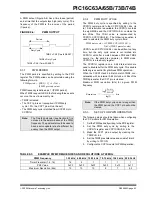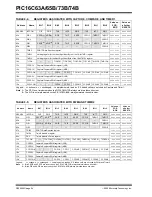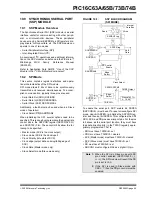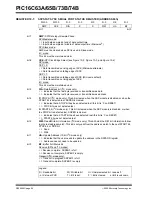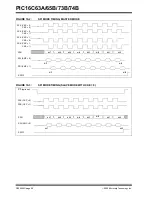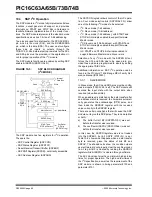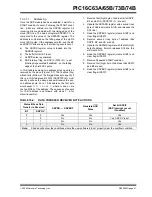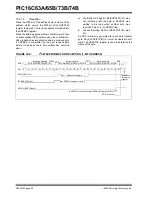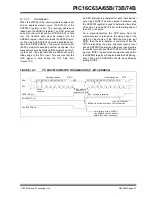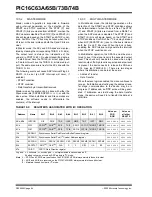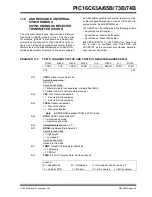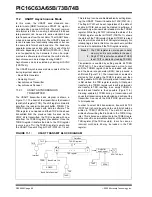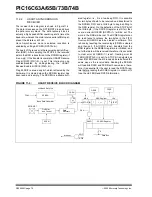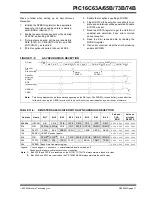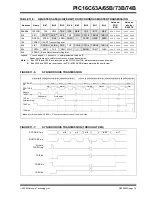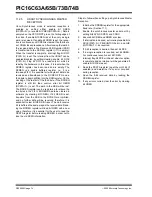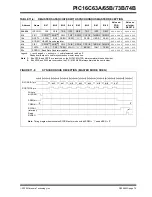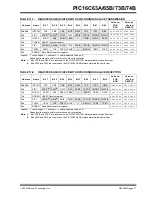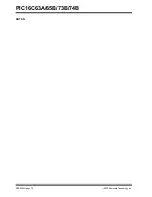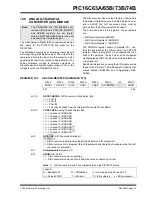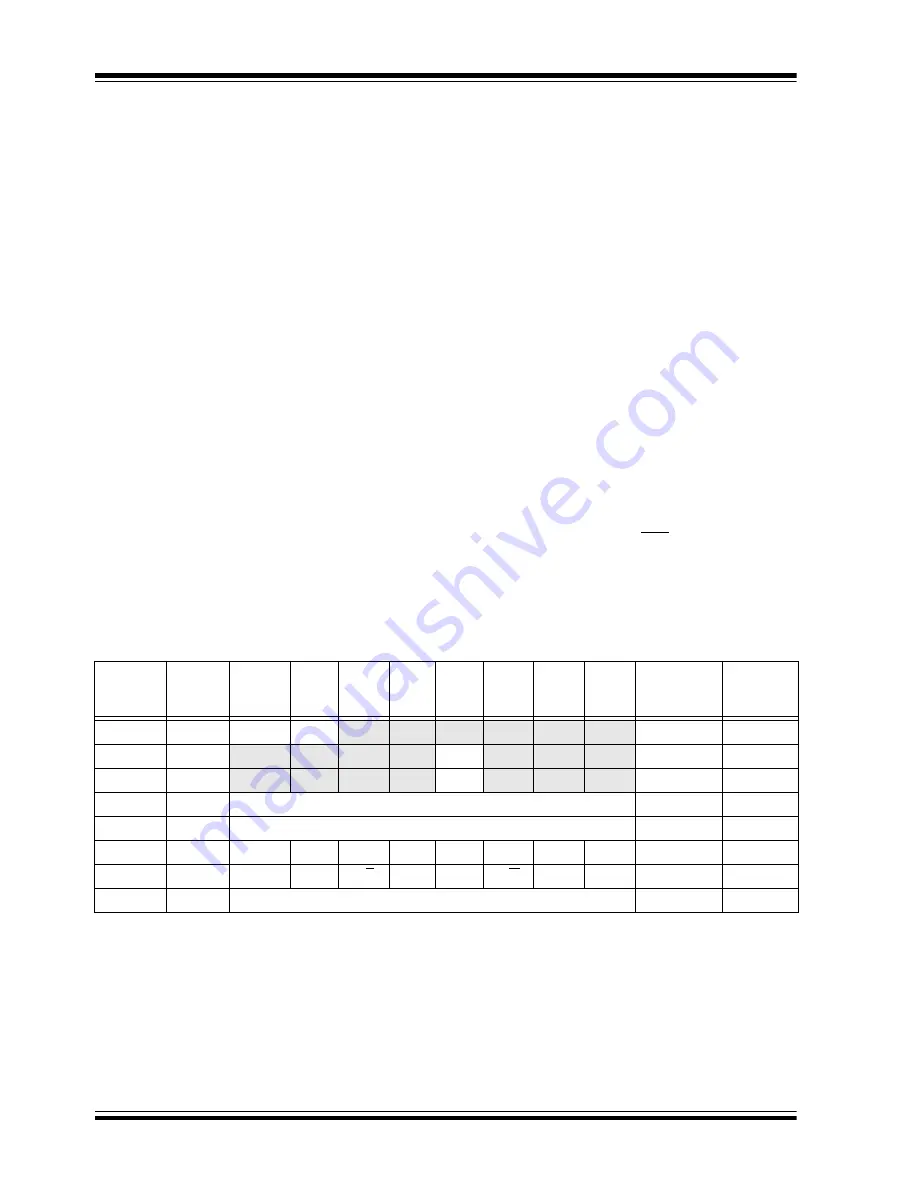
PIC16C63A/65B/73B/74B
DS30605C-page 64
2000 Microchip Technology Inc.
10.3.2
MASTER MODE
Master mode of operation is supported in firmware
using interrupt generation on the detection of the
START and STOP conditions. The STOP (P) and
START (S) bits are cleared from a RESET, or when the
SSP module is disabled. The STOP (P) and START (S)
bits will toggle based on the START and STOP condi-
tions. Control of the I
2
C bus may be taken when the P
bit is set, or the bus is idle and both the S and P bits are
clear.
In Master mode, the SCL and SDA lines are manipu-
lated by clearing the corresponding TRISC<4:3> bit(s).
The output level is always low, irrespective of the
value(s) in PORTC<4:3>. So when transmitting data, a
’1’ data bit must have the TRISC<4> bit set (input) and
a ’0’ data bit must have the TRISC<4> bit cleared (out-
put). The same scenario is true for the SCL line with the
TRISC<3> bit.
The following events will cause SSP Interrupt Flag bit,
SSPIF, to be set (an SSP Interrupt will occur, if
enabled):
• START condition
• STOP condition
• Data transfer byte transmitted/received
Master mode of operation can be done with either the
Slave mode idle (SSPM3:SSPM0 =
1011
), or with the
slave active. When both Master and Slave modes are
enabled, the software needs to differentiate the
source(s) of the interrupt.
10.3.3
MULTI-MASTER MODE
In Multi-Master mode, the interrupt generation on the
detection of the START and STOP conditions allows
the determination of when the bus is free. The STOP
(P) and START (S) bits are cleared from a RESET or
when the SSP module is disabled. The STOP (P) and
START (S) bits will toggle based on the START and
STOP conditions. Control of the I
2
C bus may be taken
when bit P (SSPSTAT<4>) is set, or the bus is idle and
both the S and P bits clear. When the bus is busy,
enabling the SSP Interrupt will generate the interrupt
when the STOP condition occurs.
In Multi-Master operation, the SDA line must be moni-
tored to see if the signal level is the expected output
level. This check only needs to be done when a high
level is output. If a high level is expected and a low level
is present, the device needs to release the SDA and
SCL lines (set TRISC<4:3>). There are two stages
where this arbitration can be lost, these are:
• Address Transfer
• Data Transfer
When the slave logic is enabled, the slave continues to
receive. If arbitration was lost during the address trans-
fer stage, communication to the device may be in
progress. If addressed, an ACK pulse will be gener-
ated. If arbitration was lost during the data transfer
stage, the device will need to re-transfer the data at a
later time.
TABLE 10-3:
REGISTERS ASSOCIATED WITH I
2
C OPERATION
Address
Name
Bit 7
Bit 6
Bit 5
Bit 4
Bit 3
Bit 2
Bit 1
Bit 0
Value on:
POR,
BOR
Value on
all other
RESETS
0Bh, 8Bh
INTCON
GIE
PEIE
T0IE
INTE
RBIE
T0IF
INTF
RBIF
0000 000x
0000 000u
0Ch
PIR1
PSPIF
(1)
ADIF
(2)
RCIF
TXIF
SSPIF CCP1IF TMR2IF TMR1IF
0000 0000
0000 0000
8Ch
PIE1
PSPIE
(1)
ADIE
(2)
RCIE
TXIE
SSPIE CCP1IE TMR2IE TMR1IE
0000 0000
0000 0000
13h
SSPBUF
Synchronous Serial Port Receive Buffer/Transmit register
xxxx xxxx
uuuu uuuu
93h
SSPADD
Synchronous Serial Port (I
2
C mode) Address register
0000 0000
0000 0000
14h
SSPCON
WCOL
SSPOV SSPEN
CKP
SSPM3 SSPM2 SSPM1 SSPM0
0000 0000
0000 0000
94h
SSPSTAT
SMP
(3)
CKE
(3)
D/A
P
S
R/W
UA
BF
0000 0000
0000 0000
87h
TRISC
PORTC Data Direction register
1111 1111
1111 1111
Legend:
x
= unknown,
u
= unchanged, - = unimplemented locations read as ’0’.
Shaded cells are not used by SSP module in I
2
C mode.
Note
1: PSPIF and PSPIE are reserved on the PIC16C63A/73B; always maintain these bits clear.
2: ADIF and ADIE are reserved on the PIC16C63A/65B; always maintain these bits clear.
3: Maintain these bits clear in I
2
C mode.
Summary of Contents for PIC16C63A
Page 4: ...PIC16C63A 65B 73B 74B DS30605C page 4 2000 Microchip Technology Inc NOTES ...
Page 6: ...PIC16C63A 65B 73B 74B DS30605C page 6 2000 Microchip Technology Inc NOTES ...
Page 8: ...PIC16C63A 65B 73B 74B DS30605C page 8 2000 Microchip Technology Inc NOTES ...
Page 28: ...PIC16C63A 65B 73B 74B DS30605C page 28 2000 Microchip Technology Inc NOTES ...
Page 42: ...PIC16C63A 65B 73B 74B DS30605C page 42 2000 Microchip Technology Inc NOTES ...
Page 78: ...PIC16C63A 65B 73B 74B DS30605C page 78 2000 Microchip Technology Inc NOTES ...
Page 112: ...PIC16C63A 65B 73B 74B DS30605C page 112 2000 Microchip Technology Inc NOTES ...
Page 152: ...PIC16C63A 65B 73B 74B DS30605C page 152 2000 Microchip Technology Inc NOTES ...
Page 164: ...PIC16C63A 65B 73B 74B DS30605C page 164 2000 Microchip Technology Inc NOTES ...
Page 174: ...PIC16C63A 65B 73B 74B DS30605C page 174 2000 Microchip Technology Inc NOTES ...
Page 178: ...PIC16C63A 65B 73B 74B DS30605C page 178 2000 Microchip Technology Inc NOTES ...
Page 179: ... 2000 Microchip Technology Inc DS30605C page 179 PIC16C63A 65B 73B 74B NOTES ...
Page 180: ...PIC16C63A 65B 73B 74B DS30605C page 180 2000 Microchip Technology Inc NOTES ...
Page 181: ... 2000 Microchip Technology Inc DS30605C page 181 PIC16C63A 65B 73B 74B NOTES ...
Page 182: ...PIC16C63A 65B 73B 74B DS30605C page 182 2000 Microchip Technology Inc NOTES ...
Page 183: ... 2000 Microchip Technology Inc DS30605C page 183 PIC16C63A 65B 73B 74B NOTES ...




